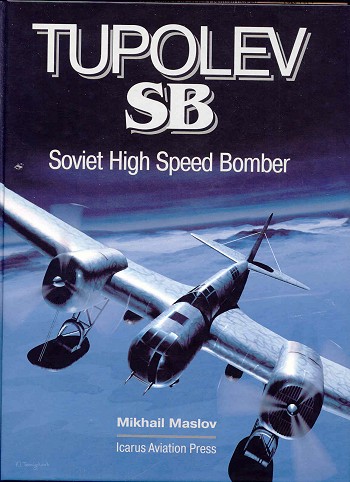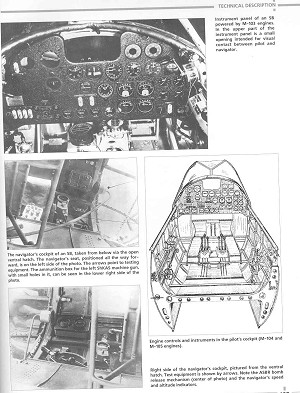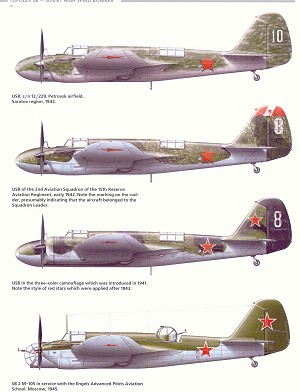 The Tupolev SB was a state-of-the-art bomber when it
first appeared in the Soviet Union during 1934, and it went through
protracted development during the middle and late thirties, seeing action
first with the Spanish Republicans during the Spanish Civil War, and later
with the Chinese and the Soviets against the Japanese prior to Pearl
Harbor.
The Tupolev SB was a state-of-the-art bomber when it
first appeared in the Soviet Union during 1934, and it went through
protracted development during the middle and late thirties, seeing action
first with the Spanish Republicans during the Spanish Civil War, and later
with the Chinese and the Soviets against the Japanese prior to Pearl
Harbor.
Initially designated BB, and shortly afterwards, SB,
for High Speed Bomber, the actual prototype was called the ANT-40 by the
design bureau, and the designations, along with other details of the
bomber, and its development and operational service, remained obscure and
confusing to Western historians due to the lack of technical information
coming from the Soviet Union. Now that things have changed, and
information is more available, various writers have published more
accurate and reliable information on the various Soviet aircraft used
during the Communist Era.
One notable change has been the emergence of a number
of Russian historians who are trying to “set the record straight” by
providing accurate information on Soviet aircraft backed up by official
documentation from primary historical sources, rather than the sometimes
inaccurate data provided by secondary sources.
Probably one of the most famous Soviet pre-World War
II bombers, the Tupolev SB first appeared during 1934 This aircraft
pioneered a number of design features for Soviet aircraft, and was probably
one of the most advanced aircraft of its class in the world at the time.
Featuring such innovations as all metal construction, retractable
landing gear, enclosed cockpits, internal bomb stowage, and controllable
pitch propellers, the SB was produced in considerable numbers prior to the
outbreak of war in Europe, and although it was the major Soviet light
bomber at the beginning of the war, the design was already six years old,
and aeronautical developments had rendered it obsolescent by the time it
was committed to combat against the Luftwaffe, which was equipped with
modern fighters. It did not fare too well against Messerschmitts and Focke
Wulfs, although it must be remembered that the majority of these aircraft
were destroyed on the ground during the first few days of the German
attacks.
 The Maslov book, in hardcover, contains 224 pages of
high quality text; previously unpublished photos, excellent detail
drawings, some of which appear to be from manufacturer’s or maintenance
manuals; highly accurate 1/72 scale three view drawings of virtually
every variant of the design, including the civil variants and special
modifications, and 16 pages of excellently drawn color profile drawings,
also in 1/72 scale, depicting the SB in Soviet military and civilian,
Spanish, Finnish, Czech, Slovak, Bulgarian, Chinese. and German service.
The Maslov book, in hardcover, contains 224 pages of
high quality text; previously unpublished photos, excellent detail
drawings, some of which appear to be from manufacturer’s or maintenance
manuals; highly accurate 1/72 scale three view drawings of virtually
every variant of the design, including the civil variants and special
modifications, and 16 pages of excellently drawn color profile drawings,
also in 1/72 scale, depicting the SB in Soviet military and civilian,
Spanish, Finnish, Czech, Slovak, Bulgarian, Chinese. and German service.
The book is excellent in all respects, with high
quality reproduction of photographs, fine line drawings, and good color
register. It covers the entire development and service use of the SB, and
includes not only the technical development, but personal accounts of what
the aircraft was like to fly in combat, and also references to the
political pressures placed on their designers in the late thirties,
especially during the Purge Trials, when a number of aircraft designers
actually worked on their designs from prisons while they were considered to
be “politically unreliable”. The background of the Tupolev Design Bureau
is also covered in depth, along with the aircraft they developed along the
way to the production of the SB bomber. The author also describes the
unsuccessful attempts to create a successor to the SB, which was replaced
in Soviet bomber squadrons by the Petylyakov Pe-2 at the beginning of the
war.
This book is a wealth of information for the modeler
for a number of reasons. Not only does it cover EVERY variant of the
design, but it provides drawings that could be used to convert a model into
whatever variant the modeler wishes. Excellent photos and drawings give
detailed information on cockpit interiors, turrets, wheel wells, and any
other area that the modeler would wish to superdetail. The color pages
provide a wealth of information, with plan views as well as side profiles,
including 66 drawings, not to mention the color photos on the back cover.
Another feature is the section on the only surviving
SB, and how it came to be placed on exhibit at the Russian Air Force Museum
at Minino, Russia, outside of Moscow. This is an interesting story in
itself, although it is mentioned that there may be other surviving wrecked
aircraft that have not been recovered, as it seems that many World War II
vintage aircraft are just now being discovered in Russia and recovered for
restoration. A few vintage Russian aircraft are even flying again, but it is doubtful that
an SB will ever be seen in the air again.
This book is impressive for a number of reasons. The
extent of research, with Russian source material close at hand, is
impressive. The photos, many obviously taken by individuals rather than
officials (although not credited to sources), are impressive, especially
since photography of aircraft must have been very difficult during Stalin’s
regime, when everyone was suspected of disloyalty. With the drawings and
color views, this publication will undoubtedly become the definitive work
on this historically significant airplane, and will provide the modeler and
historian with a wealth of information, allowing for the superdetailing of
a model of the aircraft in virtually any scale.
KITS
By the way, there are currently two 1/72 scale kits
of the SB available. The old Frog kit has to be almost forty years old by
now, and is very crude by modern standards. It is basically accurate in
outline, and depicts the M-100 variant with the flat frontal radiators
with two or three bladed propellers. With a lot of work, a decent model
could be made. Recently a new kit of the AR-2 dive bomber was produced in
Eastern Europe, and although it has vacuformed canopies, it does build
into a good model. Pavla is rumored to be producing an SB to modern
standards, although I haven’t seen this one yet.
This is certainly an airplane that belongs in any
representative model collection, and the Maslow book certainly provides
enough information to model any specific variant.
This book is highly recommended, and is fascinating
reading.
January 2005
The publisher has recently moved to the following
address: Icarus Aviation Press, 2459 Hwy 14, Columbia, IA 50057. Email
address is icarus@icarusbooks.com
If you would like your product reviewed fairly and quickly by a
site that has 300,000 visitors a month, please contact
me or see other details in the Note to
Contributors.
 The Tupolev SB was a state-of-the-art bomber when it
first appeared in the Soviet Union during 1934, and it went through
protracted development during the middle and late thirties, seeing action
first with the Spanish Republicans during the Spanish Civil War, and later
with the Chinese and the Soviets against the Japanese prior to Pearl
Harbor.
The Tupolev SB was a state-of-the-art bomber when it
first appeared in the Soviet Union during 1934, and it went through
protracted development during the middle and late thirties, seeing action
first with the Spanish Republicans during the Spanish Civil War, and later
with the Chinese and the Soviets against the Japanese prior to Pearl
Harbor. The Maslov book, in hardcover, contains 224 pages of
high quality text; previously unpublished photos, excellent detail
drawings, some of which appear to be from manufacturer’s or maintenance
manuals; highly accurate 1/72 scale three view drawings of virtually
every variant of the design, including the civil variants and special
modifications, and 16 pages of excellently drawn color profile drawings,
also in 1/72 scale, depicting the SB in Soviet military and civilian,
Spanish, Finnish, Czech, Slovak, Bulgarian, Chinese. and German service.
The Maslov book, in hardcover, contains 224 pages of
high quality text; previously unpublished photos, excellent detail
drawings, some of which appear to be from manufacturer’s or maintenance
manuals; highly accurate 1/72 scale three view drawings of virtually
every variant of the design, including the civil variants and special
modifications, and 16 pages of excellently drawn color profile drawings,
also in 1/72 scale, depicting the SB in Soviet military and civilian,
Spanish, Finnish, Czech, Slovak, Bulgarian, Chinese. and German service.